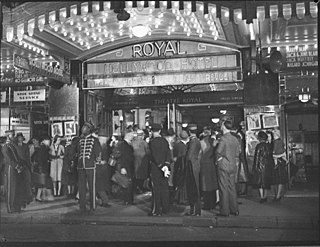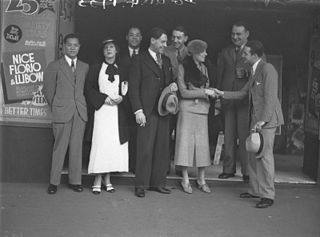
George Musgrove was an English-born Australian theatre producer.
John Lazar was an actor and theatre manager in Australia. He was Mayor of Adelaide from 1855 to 1858.

Theatre Royal Sydney is a theatre in Sydney, Australia built in 1976 and has offered a broad range of entertainment since the 1990s. The theatre reopened in December 2021 under parent company Trafalgar Entertainment with patrons now able to book tickets directly from the venue itself with its Box Office operating 7 days a week.

The Criterion Theatre was a theatre in Sydney, Australia which was built in 1886 by architect George R Johnson on the south east corner of Pitt and Park streets. It closed in 1935 and the building was demolished.

George Marlow was an Australian theatrical entrepreneur born in London of Jewish extraction, noted for bringing melodrama and pantomime to Sydney audiences in the early 1900s. His name has been frequently mis-spelled as "George Marlowe".
The MacMahon brothers were entrepreneurs in Australian show business. Chief among them were James MacMahon and Charles MacMahon, who together and separately toured a large number of stage shows. Their younger brothers, Joseph and William, were involved in many of those activities.

The New Tivoli Theatre, Sydney, previously known as the Adelphi Theatre and the Grand Opera House, was a theatre and music hall at 329, Castlereagh Street, Sydney, Australia, which was long at the heart of the Tivoli circuit.
James Allison was a theatre manager in Sydney, Adelaide and Melbourne. He engaged and managed local and overseas opera, drama, circus, minstrel and variety companies throughout the Australasian colonies.
Samuel Lazar was an Australian theatre manager, producer of pantomimes and operas, and occasional actor.
Joseph Wyatt was a theatre owner and manager, in the early years of theatre in Sydney, Australia.
William John Wilson was a British actor and theatre scenery painter, who had a career in Australia that included theatre management.
The Royal Lyceum was a small theatre in York Street, Sydney founded in 1854, which was redeveloped and renamed many times, finally as the Queen's Theatre, by which name it closed in 1882.

Frou-Frou is an English adaptation of a French comedic play of the same name written by Henri Meilhac and Ludovic Halévy. The title role has been played by many actors, notably Sarah Bernhardt, Madame Modjeska, and Ellen Terry.
Frank Towers (1835–1886) was an English actor, playwright and stage producer.

The Prince of Wales was a theatre in Castlereagh Street, Sydney, New South Wales. It was destroyed by fire and rebuilt twice; the second time as the Theatre Royal.
Edmund Holloway was an Australian actor.
Henry Richard Harwood was an Australian actor and theatre manager.
William Dind was an hotelier and theatre manager in Sydney, Australia, where he was the longtime lessee of the Royal Victoria, and Prince of Wales theatres. He settled on Sydney's North Shore, where he was active in local government, and he and his son William Forster Dind, aka W. Forster Dind or William Dind jun, ran hotels which were popular with theatrical people.
Mary Gladstane was an Irish-American actress of the 19th-century who had a considerable career in Australia, along with her husband and manager, L. M. Bayless.
Fanny Emily Mary Hooper, known as Minnie Hooper, was an Australian dance instructor and ballet mistress. She has been credited, with Jennie Brenan and Minnie Everett, with maintaining the high standard of Australian dance and ballet in the 1920s, between the reigns of Emilia Pasta and Anna Pavlova. She had a long series of contracts with J. C. Williamson's and conducted classes at her dance studio on Pitt Street, Sydney.







